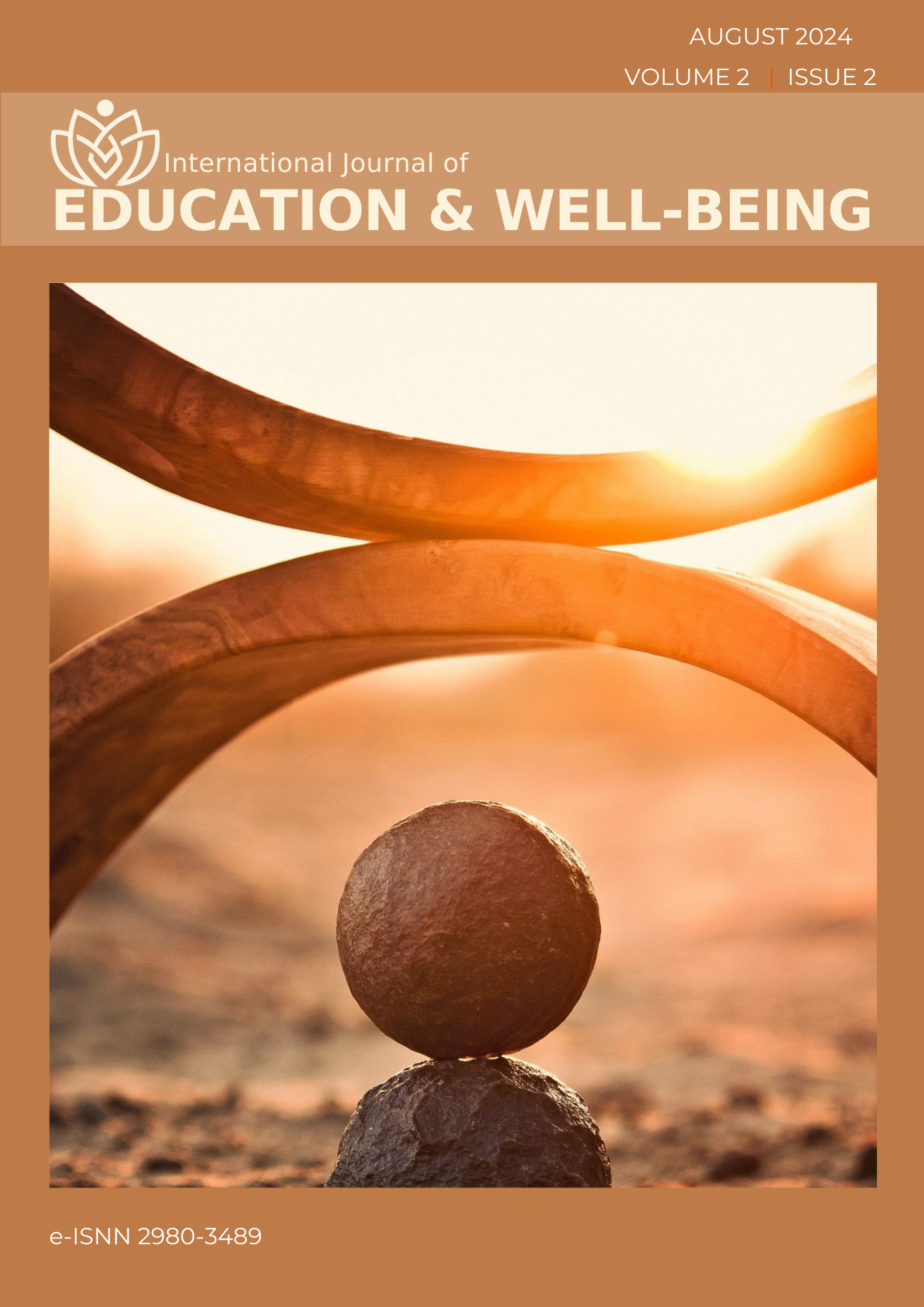The Examination of the Relationship Between Intercultural Sensitivity and Life Satisfaction of Foreign Students Receiving Turkish Language Education
The Examination of the Relationship Between Intercultural Sensitivity and Life Satisfaction of Foreign Students Receiving Turkish Language Education
DOI:
https://doi.org/10.62416/ijwb-39Keywords:
Intercultural communication competence, intercultural sensitivity, Turkish education for foreigners, student, life satisfactionAbstract
This study aims to determine the levels of intercultural sensitivity and life satisfaction among students enrolled in Turkish language preparatory programs for foreign students. The research examines the effects of variables such as department, gender, region of residence, international experiences, and friendships with individuals from different cultures. Utilizing a quantitative research method within a survey model, the study's participant group comprised 196 volunteer students from various departments at International Final University during the spring semester of 2022/2023. Data were collected using the "Intercultural Sensitivity Scale" and the "Life Satisfaction Scale" and analyzed with SPSS-24 software. The findings revealed that the participants generally exhibited above-average levels of intercultural sensitivity and life satisfaction, with these levels varying according to demographic variables such as gender, upbringing location, and having friends from other cultures. Female students demonstrated higher levels of intercultural sensitivity and life satisfaction compared to their male counterparts. Additionally, students raised in urban areas exhibited higher sensitivity and satisfaction levels than those from rural areas. The study also found that students with friends from diverse cultural backgrounds had higher intercultural sensitivity and life satisfaction levels than those without. Based on these findings, it is recommended that educational programs be designed to consider cultural differences, aiming to enhance students' life satisfaction and cultural awareness. Incorporating activities that promote intercultural interaction and understanding within educational programs is crucial for fostering these skills.
References
Adler, N. J. (2021). International dimensions of organizational behavior. Mason, OH: Thompson. https://doi.org/10.1002/tie.5060280112
Akın, E. (2016). Türkçe öğretmen adaylarının kültürlerarası duyarlılıklarının çeşitli değişkenler açısından incelenmesi, Siirt Üniversitesi Örneği. Electronic Turkish Studies, 11(3), 29-42. http://dx.doi.org/10.7827/TurkishStudies.9276
Aras, B., & Şahin, D. (2017). The role of intercultural sensitivity in educational environments. Journal of Intercultural Studies, 38(2), 115-132. https://doi.org/10.1080/07256868.2017.1289905
Ayten, B., & Köse, İ. (2020). The relationship between elementary school teachers' attitudes towards foreign students and intercultural sensitivity levels. Inonu University Journal of the Graduate School of Education, 7. https://doi.org/10.29129/inujgse.790940
Barnlund, D. (1998). Communication in a global village. In M. J. Bennett (Ed.), Basic concepts of intercultural communication: A reader (pp. 35-51). https://doi.org/10.1007/978-1-4612-2994-6_1
Berry, J. W., & Kalin, R. (1995). Multicultural and ethnic attitudes in Canada: An overview of the 1991 National Survey. Canadian Journal of Behavioural Science, 27(3), 301-320. https://doi.org/10.1037/0008-400X.27.3.301
Bhawuk, D. P. S., & Brislin, R. (1992). The measurement of intercultural sensitivity using the concepts of individualism and collectivism. International Journal of Intercultural Relations, 16(4), 413-436. https://doi.org/10.1016/0147-1767(92)90031-O
Chen, G. M., & Starosta, W. J. (1997). A review of the concept of intercultural sensitivity. Human Communication, 1, 1-16.
Chen, G. M., & Starosta, W. J. (1998). The development and validation of the intercultural sensitivity scale. Human Communication, 1, 41-62.
Chen, G. M., & Starosta, W. J. (2000). The development and validation of the intercultural sensitivity scale. Human Communication, 3, 1-15. https://doi.org/10.1037/t61546-000
Chen, G. M., & Starosta, W. J. (2005). Foundations of intercultural communication. Lanham, MD: University Press of America.
Çelen, F., & Deniz, M. (2017). The relationship between intercultural sensitivity and psychological well-being of international students. Journal of International Students, 7(2), 505-519. https://doi.org/10.32674/jis.v7i2.386
Cohen, R. (2018). Multicultural education and intercultural sensitivity: A study of student attitudes. Journal of Education and Learning, 7(4), 213-221. https://doi.org/10.5539/jel.v7n4p213
Deardorff, D. K. (2020). A Model of Intercultural Competence for Academic Mobility. Journal of Studies in International Education, 24(3), 319-340. https://doi.org/10.1177/1028315319889892
Devore, J. L., & Peck, R. (2015). Statistics: The Exploration and Analysis of Data. Cengage Learning.
Hall, E. T., & Hall, M. R. (1990). Understanding cultural differences. Intercultural Press.
Hammer, M. R. (2015). The Intercultural Development Inventory: A New Frontier in Assessment and Development of Intercultural Competence. International Journal of Intercultural Relations, 48, 12-14. https://doi.org/10.1016/j.ijintrel.2015.03.002
Holliday, A. M., Hyde, M., & Kullman, J. (2004). Intercultural communication. An Advanced Resource Book. Routledge Applied Linguistics.
Holm, K., Nokelainen, P., & Tirri, K. (2009). Relationship of gender and academic achievement to Finnish students' intercultural sensitivity. High Ability Studies, 20(2), 187–200. https://doi.org/10.1080/13598130903358543
Jackson, J. (2016). Intercultural Sensitivity: A Key Component of Cultural Intelligence. Journal of Cross-Cultural Psychology, 47(10), 1240-1257. https://doi.org/10.1177/0022022116670263
Karasar, N. (2009). Bilimsel Araştırma Yöntemi. 20. Baskı. Nobel Yayın Dağıtım, Ankara.
Mihalca, R., & Grosu, D. S. (2018). The relationship between socio-demographic variables and intercultural sensitivity. Procedia-Social and Behavioral Sciences, 238, 135-141. https://doi.org/10.1016/j.sbspro.2018.03.021
Rosen, R., Digh, P., Singer, M., & Phillips, C. (2000). Global literacies: Lessons on business leadership and national cultures. New York: Simon & Schuster.
Spitzberg, B. H., & Changnon, G. (2017). Conceptualizing Intercultural Competence. In The SAGE Handbook of Intercultural Competence (pp. 2-52). Sage Publications.
Spinthourakis, J. A., Karatzia-Stavlioti, E., & Roussakis, Y. (2009). Pre-service teacher intercultural sensitivity assessment as a basis for addressing multiculturalism. Intercultural Education, 20(3), 267-276. https://doi.org/10.1080/14675980903138624
Stafford, J. R., Bowman, R., Ewing, T., Hanna, J., & Lopez-De Fede, A. (1997). Building Culture Bridges. Bloomington, IN: National Educational Service.
Thorn, M. (2002). Leadership in international organizations: Global leadership competencies. Retrieved August 1, 2008, from http://www.academy.umd.edu/publications/global_leadership/marlene_thorn.htm
Toomey, A. H., & Chung, B. Y. (2020). Communication barriers and intercultural understanding in digital contexts. Journal of Digital Communication, 9(1), 77-89. https://doi.org/10.1080/21632324.2020.1741234
Verkuyten, M. (2006). Multicultural recognition and ethnic minority rights: A social identity perspective. European Review of Social Psychology, 17, 148–184. https://doi.org/10.1080/10463280600937418
Üstün, A. (2011). Adaptation of the Intercultural Sensitivity Scale into Turkish. Journal of Language and Literature Education, 2(4), 28-39.
Dağlı, A., & Baysal, Z. (2016). Adaptation of the Satisfaction with Life Scale into Turkish: Validity and reliability study. Journal of Education and Research, 6(2), 25-32.
Seçer, İ. (2015). SPSS ve LISREL ile Pratik Veri Analizi. Anı Yayıncılık.
Tabachnick, B. G., & Fidell, L. S. (2013). Using Multivariate Statistics. Pearson Education.
Gundara, J. S. (2000). Interculturalism, Education and Inclusion. Paul Chapman Publishing.

Downloads
Published
How to Cite
Issue
Section
License
Copyright (c) 2024 Uğurcan Taşdelen

This work is licensed under a Creative Commons Attribution 4.0 International License.






